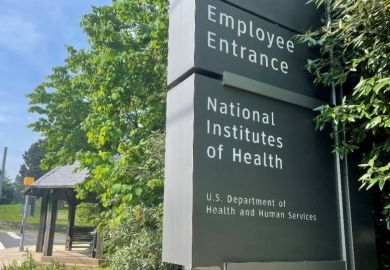The National Institutes of Health is claiming success in its efforts to steer more grant money toward younger scientists, saying it has had record-high numbers in each of the past three years.
The NIH said it awarded grants to 1,609 “early-stage” researchers in the past fiscal year, after hitting record levels of 1,412 in fiscal year 2020 and 1,513 in 2021.
The top US research grant agency defines its early-stage cohort as those who finished their terminal degree or medical residency in the past 10 years and have not already won some other substantial competitive NIH research grant.
The NIH has an annual budget of $51 billion (£40 billion), and has faced years of pressure from academic activists to improve conditions for various categories of scientists who typically have trouble competing with their older and more established colleagues.
“We have made some progress, but we still have a ways to go,” the NIH’s head of external grant awards, Mike Lauer, says in outlining the early-stage data.
NIH leaders said they attribute the recent improvements to the creation of new programmes and shifts in others that are aimed at helping younger scientists. They include the new Katz Award, which requires no preliminary data for a grant application, as a way of helping reduce the applicant’s reliance on a senior colleague.
Another initiative, the Early Independence Award, is described by NIH officials as the “Skip the Postdoc Award”, because it is intended to give scientists enough financial support that they can move straight from graduate school into a faculty-level position. “It's not for everybody,” the NIH’s acting director, Lawrence Tabak, told a recent congressional hearing, “but there are talented people out there for whom this is just an ideal circumstance.”
The NIH also has struggled for years to increase the numbers of female and black scientists who win its grant awards. Although the NIH’s initiatives to aid early career researchers are not directly designed to promote racial and gender equity, the focus on youth appears to be helping in those efforts, NIH officials said.
Other specific equity-oriented efforts, said policy analyst at the NIH, David Kosub, include agency oversight aimed at fighting bias in the peer review process, and agency guidance programmes to help researchers navigate the NIH’s application and grants processes.
Yet even with the young-scientist improvements the past three years, women still lag behind men in NIH grant awards, and the numbers of black applicants and awardees remain “markedly lower than white and Asian researchers”, Dr Lauer reports.
Hannah Valantine, professor of cardiovascular medicine at Stanford University who served as the NIH’s first chief officer for scientific workforce diversity, said she agreed that the agency has made progress on diversity on grant awards, but that “we need much more to ensure we are building a robust and diverse next generation of scientists”. The improvement for black scientists appears most evident among older researchers, Professor Valantine said. “This narrowing was less apparent in this analysis” of younger researchers, she said.
It is a long-standing lament. In leaving his 12-year tenure as the NIH’s longest-serving presidentially appointed director in late 2021, Francis Collins called the persistence of deep inequities among grant recipients one his great regrets.
Last month President Biden nominated Monica Bertagnolli to replace him. If confirmed by the US Senate, she will become only the second woman in more than a century to head the NIH or its predecessor agencies.
Register to continue
Why register?
- Registration is free and only takes a moment
- Once registered, you can read 3 articles a month
- Sign up for our newsletter
Subscribe
Or subscribe for unlimited access to:
- Unlimited access to news, views, insights & reviews
- Digital editions
- Digital access to THE’s university and college rankings analysis
Already registered or a current subscriber?








